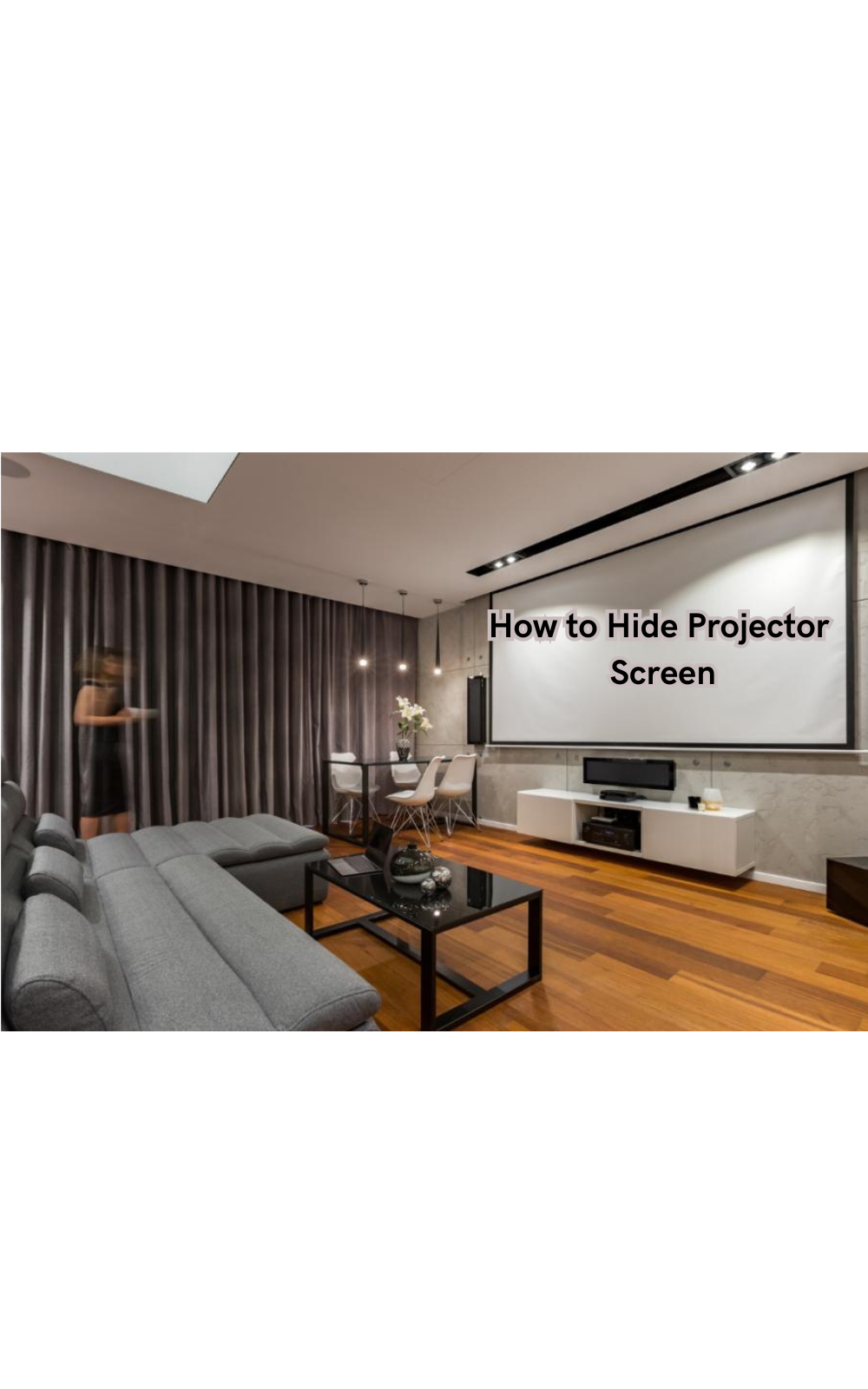How to Hide Projector Screen
This guide explores various methods to hide a projector screen, including ceiling mounts, retractable screens, and decorative elements.

In today's modern living spaces, concealing a projector screen is essential for aesthetic and functional purposes. A hidden screen maintains a clean, uncluttered appearance, enhances the overall decor, and offers flexibility in room usage.
Integrating a concealed projector screen allows you to enjoy the benefits of a home theater without compromising your room's design. This guide explores various methods to hide a projector screen, including ceiling mounts, retractable screens, and decorative elements.
Each method is detailed with practical advice on installation and maintenance, ensuring you find the best solution for your needs and room layout. Discover how to seamlessly blend technology with your home’s style.
Importance of Hiding a Projector Screen
The primary reason for hiding a projector screen is to improve the visual appeal of your living space.
A visible projector screen can become an eyesore, especially in smaller rooms, detracting from the overall design and ambiance. By concealing it, you create a more polished and cohesive look that does not compromise functionality.
Moreover, hiding a projector screen allows better use of your living space. With the rise of multipurpose rooms, where one room serves multiple functions like a home office or gym, concealing the screen enables more flexibility in room usage. You can easily switch between different activities without rearranging furniture or moving bulky screens.
Furthermore, a hidden projector screen adds an element of surprise and excitement to your home theater experience. With the press of a button or the pull of a cord, you can reveal your home theater setup, creating a cinematic atmosphere in your living room.
What Factors to Consider
Before deciding on a method to hide your projector screen, there are a few factors to consider.
Room Layout
The layout of your room is crucial in determining the best way to conceal your projector screen. If your ceiling height is low or sloped, a ceiling-mounted solution may not work. Similarly, if you have limited wall space, retractable screens may not be an option.
Taking measurements and thoroughly assessing the available space before choosing a hiding method is important.
Budget
Different methods for concealing projector screens have varying costs. Retractable screens can be more expensive than other options, while decorative elements such as curtains or paneling can be more budget-friendly.
It's best to determine your budget beforehand and explore its various options.
Maintenance
Some hiding methods, like retractable screens, may require more maintenance than others. Consider how often you plan on using your projector screen and choose a method that is easy to maintain for long-term use.
How to Hide Projector Screen
There are several ways to hide a projector screen, each with unique features and benefits. Here are some popular methods:
Ceiling Mounts
Ceiling mounts are popular for those looking to hide their projector screen. This method involves attaching the screen to the ceiling, allowing it to be discreetly hidden when not in use. Here are some tips for using ceiling mounts effectively:
- Choose a sturdy and secure mounting system that can support the weight of your screen.
- Ensure enough space above the ceiling for the screen to retract fully.
- Consider using an automatic motorized mount for easy operation.
Ceiling mounts offer a clean and minimalist look, making them ideal for modern or contemporary spaces. Since the screen is stored overhead, they also provide ample floor space, making them suitable for smaller rooms.
Retractable Screens
Retractable screens are another popular option for hiding a projector screen. These screens can be rolled up and stored when not in use, making them practically invisible. Here are some tips for using retractable screens:
- Choose a high-quality screen material that provides good image quality.
- Ensure the motorized mechanism is quiet and smooth to avoid distractions during viewing.
- Consider adding a remote control or voice command feature for easy operation.
Retractable screens offer flexibility, as they can be installed on ceilings and walls. They also come in various sizes and aspect ratios, allowing you to choose one that fits your room perfectly.
Decorative Elements
Another creative way to hide your projector screen is by incorporating decorative elements. This method allows you to have a functional yet aesthetically pleasing room. Here are some tips for using decorative elements:
- Use curtains or drapes that can be pulled back to reveal the screen.
- Install artwork or a framed mirror on the screen, making it appear as part of the decor.
- Consider building a custom cabinet that can house the projector and screen when not in use.
Decorative elements offer endless possibilities for customization, allowing you to showcase your style while hiding the screen. Depending on your mood or room usage, you can also easily switch up the decor.
Practical Advice for Installation and Maintenance
Whichever method you choose, it's essential to follow proper installation and maintenance practices to ensure the longevity of your projector screen. Here are some general tips:
- Follow manufacturer instructions for installation and use.
- Regularly clean and dust the screen to maintain image quality.
- Keep an eye on any wear and tear, and replace any damaged parts promptly.
It's also recommended to have a professional install your projector screen, especially if you opt for a ceiling-mounted or motorized solution. This will ensure proper installation and minimize the risk of damage or malfunctions.
Is Aesthetic Consideration Worth It?
Some may argue that hiding a projector screen is unnecessary and not worth the effort. However, it can be a game-changer for those who prioritize aesthetics and functionality in their living space. A well-hidden projector screen seamlessly blends into the design of your room while enhancing your viewing experience.
Moreover, with advancements in technology and design, concealing projector screens has become more accessible and affordable. Also, it adds value to your home, making it a worthwhile investment in the long run.
Where is the Best place to put a Projector in a Bedroom?
When considering the best place to put a projector in a bedroom, there are a few key factors to remember. First and foremost, the location should offer a clear view of the screen without any obstructions. This could be achieved by mounting the projector on the ceiling, placing it on a shelf, or standing above eye level.
Secondly, consider the distance between the projector and the screen. It's important to ensure the image is not distorted or too small for comfortable viewing.
Additionally, ambient light can affect the projection quality, so choose a spot away from windows or invest in blackout curtains. Lastly, think about convenience and accessibility when deciding on placement - you want to easily turn on and operate the projector from your bed.
FAQs
How can I hide an electric projector screen when not in use?
You can hide an electric projector screen by installing a recessed screen that retracts into the ceiling or a custom-built screen case. This allows the screen to be completely concealed when not in use, blending seamlessly with your other furniture.
What are some creative ways to hide a projector screen?
Creative ways to hide a projector screen include using a recessed screen that disappears into the ceiling, placing it behind other furniture, or designing a custom screen case that matches your decor. You can also paint the screen case to blend with the surrounding walls.
Can I integrate an electric projector screen with my existing decor?
Yes, you can integrate an electric projector screen with your existing decor by using a recessed screen or a screen case that matches your room's style. Painting the screen case to match the wall color or other furniture can help it blend in when the screen is not in use.
How do projectors work with hidden screens?
Projectors work seamlessly with hidden screens by projecting the image onto the screen when it is lowered. An electric projector screen can be easily raised or lowered, and when hidden, it ensures that the projector setup doesn't dominate the room's appearance.
Conclusion
In conclusion, concealing a projector screen is a smart move that enhances your living space's aesthetics and functionality.
By choosing the right method—whether it’s a ceiling mount, retractable screen, or decorative element—you can maintain a clean, uncluttered room while enjoying the flexibility of a hidden home theater system.
This guide has explored various techniques, providing practical advice on installation and maintenance to help you make an informed decision.
Consider your room’s design, functionality needs, and personal style preferences as you explore these options. Integrating a hidden projector screen can transform your living space, offering a seamless blend of technology and decor. Start implementing these solutions today to elevate your home’s style and practicality.
